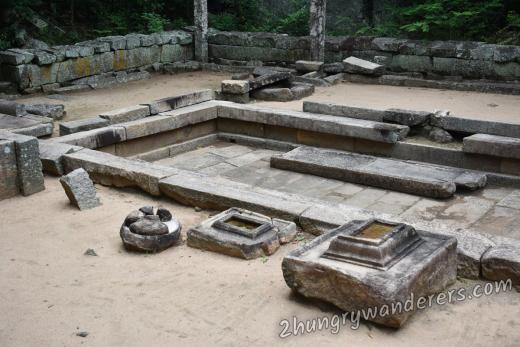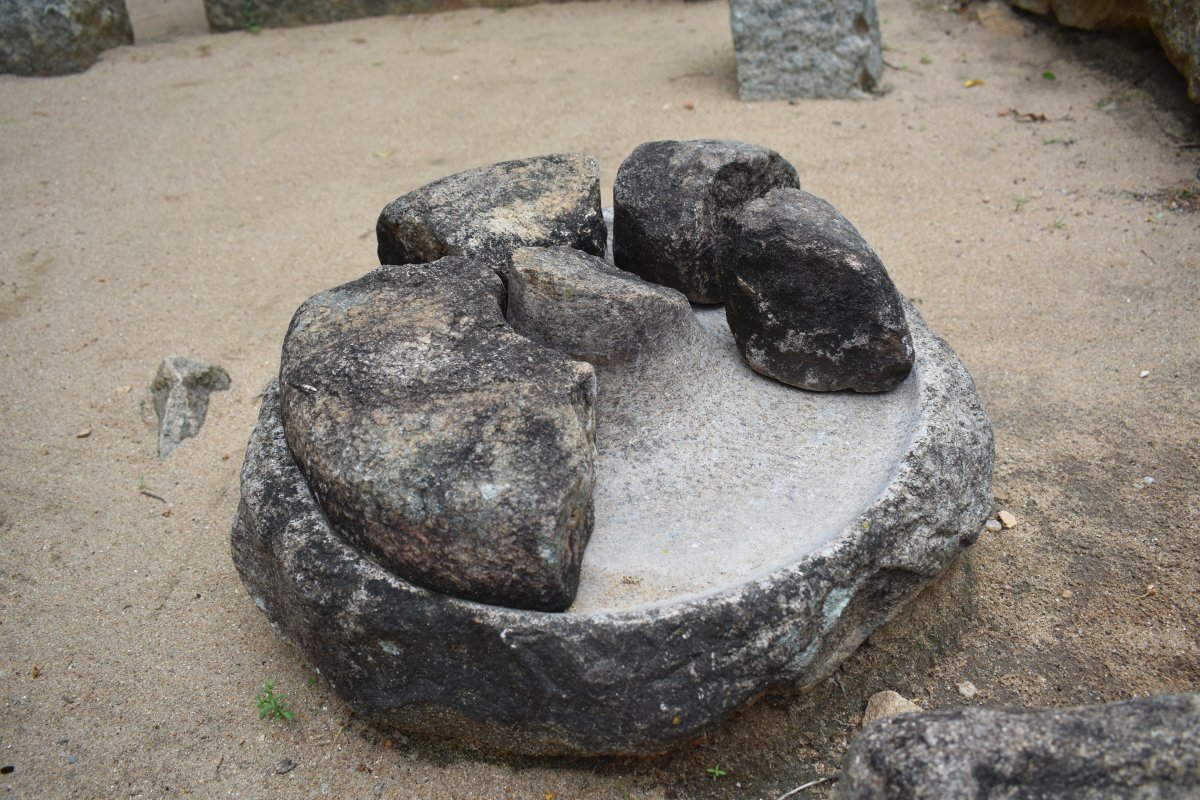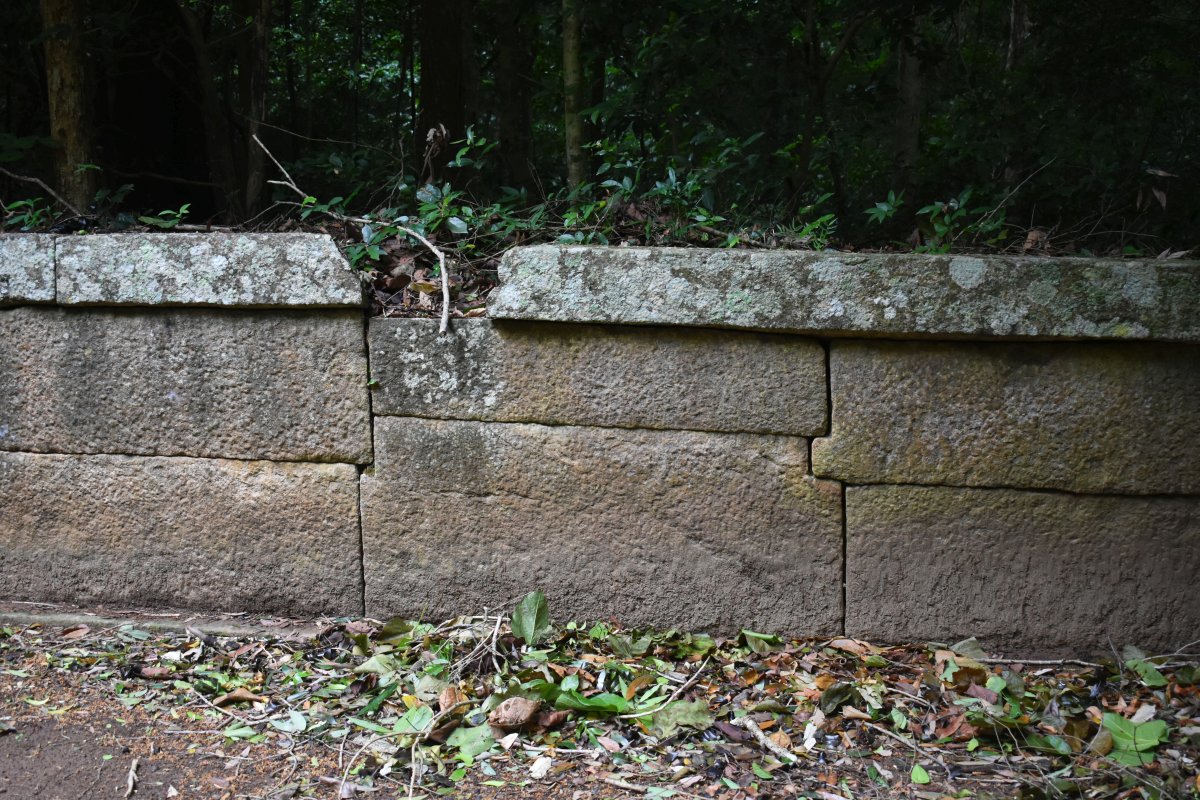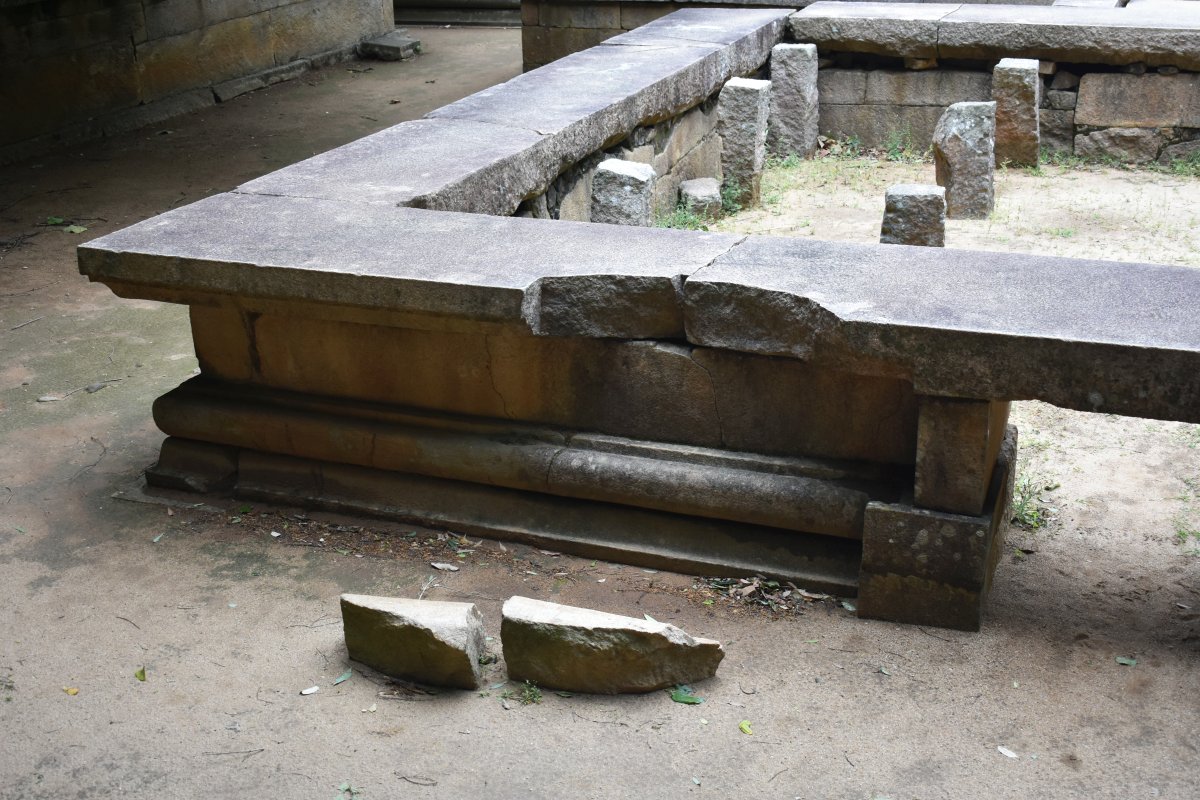
Ritigala is an ancient monastery hidden in the greenery at the foot of a mountain bearing the same name in the Northern part of Sri Lanka, 30-40 km from both Anuradhapura and Sigiriya. It is the highest mountain in the Northern region and has a peculiar weather pattern, very different from the land surrounding it. While it is dry and hot in this part of Sri Lanka, the summit has a cooler climate with more rainfall. Because of this microclimate, the flora and fauna of Ritigala are rare and unique and the mountain has been declared a strict natural reserve since 1941 in order to preserve it.
The misty mountain holds many legends. The best known is that when Laksmana, brother of Prince Rama, was wounded, the Monkey God Hanuman brought medicinal herbs from the Himalayas to heal him. On the way, he dropped a chunk of the precious plants and it fell where Ritigala is and this is the reason for the abundance of healing herbs that can be found on the summit.
The Ritigala monastic complex is more than 2 thousand years old - dated to 2BC, it was active for over a millennium, abandoned and forgotten with the end of the Anuradhapura kingdom in 10-11 century AD. The architecture of this monastery is different than other sites of the same period. No Buddha statues around, no decorations, only huge stone blocks arranged into platforms, pathways and bridges. The ascetic monks who inhabited this place are said to have rejected all worldly possessions and vanities and lived a simple life, meditating along the wide stone-paved walkways and in the simple, but solid buildings.
The site
Not many people visit Ritigala, it is mentioned in the Lonely Planet book about Sri Lanka, but is still off the beaten track, because of its remote location. No public transport runs here, and Sigiriya is about 2 hours away by car, along some very bumpy roads. If you don't have your own vehicle, getting to the forest monastery is close to impossible.
Rassagala is a another forest monastery, located close to Ampara, it is yet to gain popularity and if you are looking for less visited attractions off the tourist map it is a great place to travel to.
No map is available of the site, but once you get the general direction there is only one main path. It goes from up the ticket office and to the left to the pond Banda Pokuna, then along its left side and upwards again. The pathway from the pond is wide, covered with stone plates and there are quite a bit of stairs to climb. It goes through several cleared and restored buildings and ends in the forest at the border of the Ritigala Strict Natural reserve - a barb wire fence.
But this is not all there is. There are lots of ruins in the forest, hidden between the trees. There are narrow trails going left and right off the main track that can be explored. When at the top, there is a trail that goes on the left in the forest, it makes a circle and before it connects back to the main trail it leads through ruins of buildings, bridges, a big stone pool or well and drip-ledge caves. It takes some time to explore, but is well worth it. There are almost no signs, which makes the walk around a bit of an adventure, but distances are short and there is no real danger of getting lost.
A hike up and down the main path covering all the restored buildings takes about one - one and a half hours. We followed all the paths we found and ventured into the forest along some almost invisible trails and spent more than three hours at the site.
Our visit
We arrived at the small parking lot in the early afternoon. Got our 1000 LKR ticket from the ticket booth there and turned down an offer for a guide. We knew there might be some detours through the forest and were prepared with good shoes (not flip-flops) and enough water for a few hours of climbing in the heat of the day.
It was not as hot as the rest of the region around the mountain. The forest is thick and the shade of the trees was so deep that even the midday sun could not penetrate. But while admittedly cooler, it was very humid and we sweat quite a bit.
The first stop after the ticket booth was the man-made water reservoir Banda Pokuna. Bigger than most ponds we have seen in similar forest monasteries in Sri Lanka, it has an imposing stepped wall built of long stone blocks. There were workers restoring the wall, half of it already done, the rest still in disarray, but no less impressive. The purpose of this water tank is not clear today, some theories suggest it was a bathing pool for the monks and anyone who ventured into the monastery, while others believe it was for storing water to be used in the whole complex.

The main path itself is worth some attention - it is the actual ancient walkway and stairway of the monastery and is wide, covered with stones with interlocking plates and edged with curbstones. It leads up through the forest and past several cleared and restored foundations of buildings.


A bit to the side, on the right of the first group of restored buildings, is an ancient hospital. Scattered around you can see the grinding stones, that were used to process medicinal herbs. There is a rectangular stone bath that was filled with oils and herbs and then patient soaked in it to alleviate their illnesses.


There is a detour on a trail on the left a bit further up - it is the only marked trail (the sign was in Sinhalese only). It goes to what was signed as a Library when we visited, but the Lonely Planet book described as a fort, most probably the general consensus on what the building had been changed in the few years between our visit and the publishing of the book. A solid stone bridge over a stream still stands in its original place.


After the Library, it seemed that there was nothing more in this direction, so we went back on the main path. A couple of hours later we would come to realize that there was a path from the Library and into the forest when we reached it from the other side following a narrow trail in that branched off the main one a bit further up.
Back on the main path, we went through several clearings with foundations of structures, and the furthest up were a couple of double-platform buildings. Characteristic of the architecture of Ritigala, those structures consist of two raised stone platforms connected with a stone bridge. It is thought that there were small buildings on top of them and were used for meditation. Similar double-platform patterns can be seen in other ancient monasteries in the country of the Anuradhapura period.


The main footpath ends abruptly, a dirt path continues for a short distance and disappears after the fence of the strict natural reserve. When we reached the top, I have to admit, we were a bit disappointed. "Was that it?" we thought. It took us about 40 minutes to get there and while it was interesting, it felt like it did not live up to our expectations.

We stood there, trying to get some mobile network coverage on our phone to make sure we were not missing anything, but so far up the mountain, we had no luck. From our research of the place previous, there was information about ruins in the forest, but we had explored the only side trail we found, it led to the Library and there were no more. We were sure that was not all, we must have missed something, but short of going straight into the forest, we could not figure out another way. Maybe it was time to just call it a day and go back.
There was a big tree near the end of the path and while walking around to take photos of all angles we noticed there was a very narrow path into the forest. It seemed more like an animal trail, but we followed it anyway and got to an ancient toilet - surprisingly similar to the squatting toilets used today.

So, that was our mistake - we expected the side trails to be marked, or at least easy to spot, but they weren't. We started to look more closely and going back down we found a trail on the right. We decided to give it a go. It went into the forest and at places it was barely distinguishable. We had doubts whether it would lead us anywhere meaningful, but pushed on despite that. We tried to memorize markers along it, in case we had to backtrack. The shoes really came through here - it would have been very unpleasant to trek through the jungle in flip-flops.


As it turned out, this was the right trail. The overgrown narrow path meandered around ruins buried in the jungle - mounds of earth and bricks with granite columns that once supported roofs sticking out, trees growing out of remains of double-platform structures, the huge rock blocks covered in dry leaves, water pipes carved of stone scattered on the ground.



In a small clearing, we found a big stone bathing pond, or possibly a well. There was no signage around it and the hardly noticeable trail was the only way to it.

The narrow trail then led us to several drip-ledge caves. Remains of brick walls suggested the caves had been closed off and used as buildings. Then the path circled back to the Library and the main walkway.


There are similar trails on the other side of the main one, going to other yet unexplored structures covered by the jungle - wide stone paths used as meditation walks and more double-platform buildings.
We spent about 3 hours walking around the complex, first along the main pathway, and then following side trails to ruins buried by layers of dry leaves, earth and trees. While the restored structures along the main track were very interesting, we enjoyed discovering the buildings and stone structures swallowed by the jungle and exploring the long lost world even more than that.
Comments